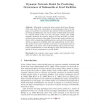Free Online Productivity Tools
i2Speak
i2Symbol
i2OCR
iTex2Img
iWeb2Print
iWeb2Shot
i2Type
iPdf2Split
iPdf2Merge
i2Bopomofo
i2Arabic
i2Style
i2Image
i2PDF
iLatex2Rtf
Sci2ools
BIOSURVEILLANCE
2008
Springer
2008
Springer
Dynamic Network Model for Predicting Occurrences of Salmonella at Food Facilities
Salmonella is among the most common food borne illnesses which may result from consumption of contaminated products. In this paper we model the co-occurrence data between USDA-controlled food processing establishments and various strains of Salmonella (serotypes) as a network which evolves over time. We apply a latent space model originally developed for dynamic analysis of social networks to predict the future link structure of the graph. Experimental results indicate predictive utility of analyzing establishments as a network of interconnected entities as opposed to modeling their risk independently of each other. The model can be used to predict occurrences of a particular strain of Salmonella in the future. That could potentially aid in proactive monitoring of establishments at risk, allowing for early intervention and mitigation of adverse consequences to public health.
BIOSURVEILLANCE 2008 | Food Borne Illnesses | Food Processing Establishments | Salmonella | Security Privacy |
| Added | 12 Oct 2010 |
| Updated | 12 Oct 2010 |
| Type | Conference |
| Year | 2008 |
| Where | BIOSURVEILLANCE |
| Authors | Purnamrita Sarkar, Lujie Chen, Artur Dubrawski |
Comments (0)

